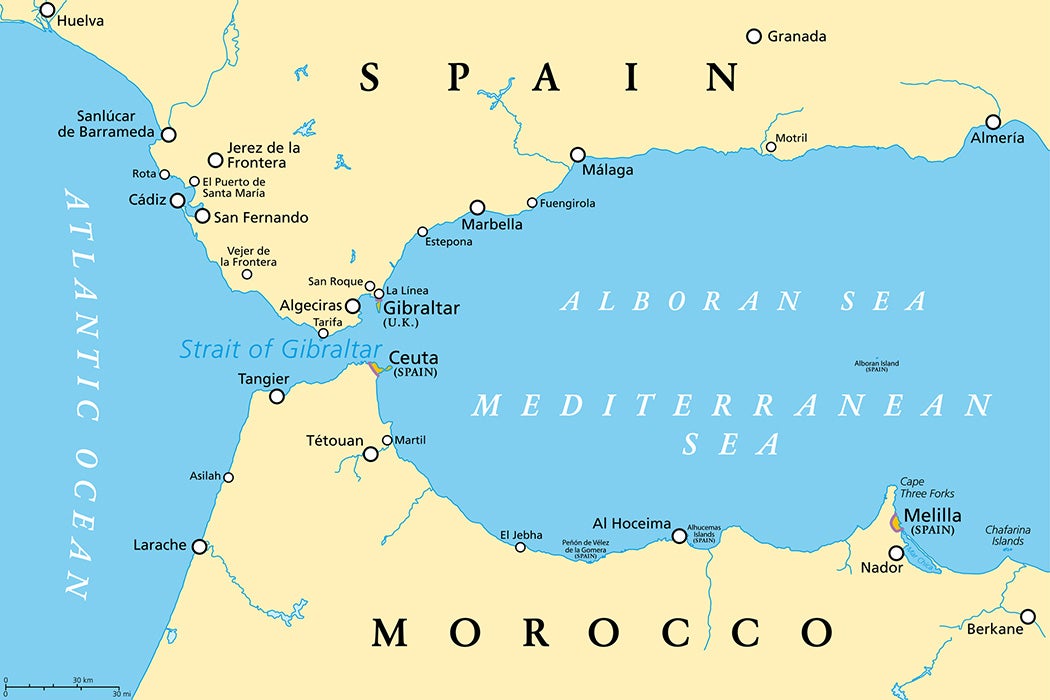The “teatime islands,” as the crumbs of Britain’s former empire have been colloquially named, are a recherché array of a dozen or so islands, mainly in the Caribbean, but also found in the Atlantic, Pacific, and Indian Oceans. They’re as obscure as they are remote, which makes Gibraltar a decidedly odd companion territory when compared to the easy pace of life in backwaters such as Pitcairn, Montserrat, or St. Helena.
Gibraltar is a piece of Britain surrounded by the Spanish mainland and the Mediterranean Sea. Far from being a hushed and sandy hangover from colonial times, Gibraltar is a clamorous working town of 30,000 people, clinging to the base of a 1,396-foot-high boulder.
Originally known as Mons Calpe, Gibraltar’s gargantuan rock was regarded as one of the Pillars of Hercules (with the hill of Ceuta as its companion). The pillars, as theorized by Gary M. Turnquist in 1974, attest to the claim of the ancient Phoenicians to the region, as the landmarks were used not only to “display the spatial characteristics presented by their temples to their god Melkarth” but also as synonyms for the western extremes of their trading network.
Fast forward to the early eighteenth century as explored by Geoffrey Plank in an article in the journal History. Myriad battles for control over Gibraltar were fought in this period, with British, Dutch, and Austrian generals and rulers having avaricious designs on the territory. As Plank shares, a British pamphlet published in 1704 noted Gibraltar’s potential to serve as a “sanctuary” for England’s navy and merchant fleet, protecting ships “in times of distress, either by Weather or the Enemy.”
The Treaty of Utrecht awarded the territory to the United Kingdom in 1713–14, and it’s remained in British hands ever since, to the frequent chagrin of Spanish monarchs and rulers—most notably General Franco, who closed the land borders between Gibraltar and Spain and severed all communication links, a situation that wasn’t fully rescinded until 1985.

Gibraltar’s admirable physical capacity to withstand attack and provide sanctuary was demonstrated most notably during the Second World War when extensive tunnels were dug into the Rock and the territory was used to plan the Desert Torch operation in North Africa. Because it was the only piece of continental Europe in Allied hands, the island’s civilian population was entirely evacuated for the war effort, a displacement that resulted in many Gibraltarians never seeing their homeland again. Today, the historic and cultural ties to the UK have created a unique—and complex—set of identity issues for Gibraltarians, giving them “…a sense of themselves as a distinctive community, different from Spain and, indeed, different from Britain also.”
The confusing albeit alluring mixing of nationalities is obvious while walking around the Old Town. The houses and distinctly Spanish-looking labyrinthine streets and alleys below the Rock are peppered with English street names, English telephone boxes, and old-fashioned English pubs with names like “The Lord Nelson” that serve Sunday roasts, warm ales, and full English fry-up breakfasts.
Weekly Newsletter
It’s an unlikely, and unique, melding of two very different European styles of living. But Gibraltar’s dining options and culture wars aren’t too relevant to the Rock’s most famous inhabitants. The Barbary macaques are Europe’s only wild monkeys (though they are supplied with food by locals). As Lara Modolo, Walter Salzburger, Robert D. Martin, and F. Clark Howell note in a study based on the analysis of the colony’s mitochondrial DNA (mtDNA), how the macaques came to live on Gibraltar is the stuff of legends. The mtDNA results suggest that the monkeys have ties to Algerian and Moroccan populations, though they’re genetically distinct from both African groups. Modolo et al. argue that, given this genetic distinctiveness, efforts should be made to protect all three groups, but with tensions between tourists who adore the monkeys and Gibraltar locals, many of whom consider macaques troublesome pests, it’s not clear how conservation policies will develop.
Local lore has it that if the primates do depart Gibraltar, the British will soon follow. Judging by the present population of more than 300 macaques and a human population fiercely loyal to the UK, the Spanish-British political tensions over control of this unique and beautiful peninsula—much like the human-macaque tensions—look unlikely to abate anytime soon.
Support JSTOR Daily! Join our membership program on Patreon today.







